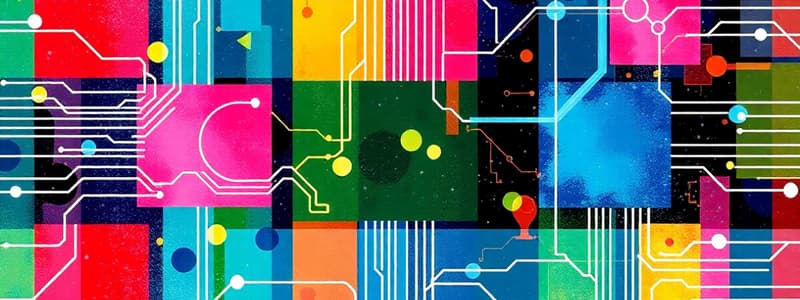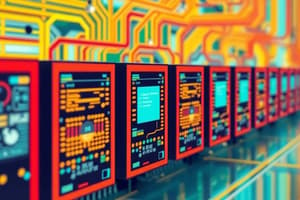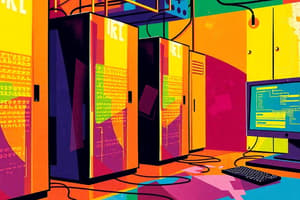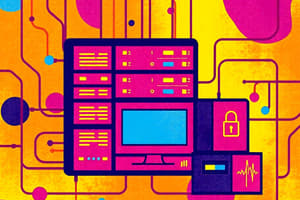Podcast
Questions and Answers
Which of the following technological advancements is associated with the 19th century?
Which of the following technological advancements is associated with the 19th century?
- Steam engine (correct)
- Computer Networks
- Mechanical systems
- Information gathering, distribution, processing and creation
In the context of the 20th-century technology revolution, which element focuses on converting data into a meaningful format for the recipient?
In the context of the 20th-century technology revolution, which element focuses on converting data into a meaningful format for the recipient?
- Gathering
- Distribution
- Processing
- Creating (correct)
Which of the following is an example of a communication link?
Which of the following is an example of a communication link?
- Printer
- Computer
- Coaxial cable (correct)
- Router
Which of the following best describes a computer network?
Which of the following best describes a computer network?
Which term refers to an 'interconnected collection of autonomous computers'?
Which term refers to an 'interconnected collection of autonomous computers'?
What is the process of converting between bits and signals that represent them called?
What is the process of converting between bits and signals that represent them called?
Which multiplexing technique involves channels being shared by signals at different times?
Which multiplexing technique involves channels being shared by signals at different times?
In the context of Code Division Multiplexing (CDM), what is being recovered in the recovery of station C's?
In the context of Code Division Multiplexing (CDM), what is being recovered in the recovery of station C's?
Which of the following is an example of a business application of networks?
Which of the following is an example of a business application of networks?
What does the client-server model primarily describe in the context of network applications?
What does the client-server model primarily describe in the context of network applications?
When a client initially contacts a server using TCP sockets, what action does the server typically perform?
When a client initially contacts a server using TCP sockets, what action does the server typically perform?
Which of the following is a key characteristic of TCP (Transmission Control Protocol) in the context of socket programming?
Which of the following is a key characteristic of TCP (Transmission Control Protocol) in the context of socket programming?
Which application is an example of person-to-person communication?
Which application is an example of person-to-person communication?
In a peer-to-peer (P2P) network, what is a defining characteristic regarding the roles of clients and servers?
In a peer-to-peer (P2P) network, what is a defining characteristic regarding the roles of clients and servers?
If a mobile user accesses a network in an older, unwired building, which combination of network characteristics applies?
If a mobile user accesses a network in an older, unwired building, which combination of network characteristics applies?
Which type of network covers the largest geographical area?
Which type of network covers the largest geographical area?
What type of network is most likely used to connect devices within a room?
What type of network is most likely used to connect devices within a room?
What is a key characteristic of broadcast links in network hardware?
What is a key characteristic of broadcast links in network hardware?
What is a key feature of multicasting?
What is a key feature of multicasting?
Which of the following is an essential component of a computer network?
Which of the following is an essential component of a computer network?
What is a primary advantage of a Wireless Local Area Network (WLAN)?
What is a primary advantage of a Wireless Local Area Network (WLAN)?
What is a significant disadvantage of Wireless Local Area Networks (WLANs)?
What is a significant disadvantage of Wireless Local Area Networks (WLANs)?
In the context of network usage, what is the term for systems where multiple components located on different machines work together?
In the context of network usage, what is the term for systems where multiple components located on different machines work together?
What is the primary purpose of resource sharing in business applications of networks?
What is the primary purpose of resource sharing in business applications of networks?
What is a bulletin board system (BBS) primarily used for in business communication?
What is a bulletin board system (BBS) primarily used for in business communication?
Which of the following is an example of electronic commerce in home applications?
Which of the following is an example of electronic commerce in home applications?
What is the defining characteristic of 'ubiquitous computing' in home applications?
What is the defining characteristic of 'ubiquitous computing' in home applications?
What is a common concern related to the increasing use of networks and technology?
What is a common concern related to the increasing use of networks and technology?
What is unicasting within the context of network hardware?
What is unicasting within the context of network hardware?
Which network type is typically characterized by privately-owned networks within a single building or campus, spanning up to a few kilometers?
Which network type is typically characterized by privately-owned networks within a single building or campus, spanning up to a few kilometers?
In the context of network hardware organization, what defines a Metropolitan Area Network (MAN)?
In the context of network hardware organization, what defines a Metropolitan Area Network (MAN)?
In a Wide Area Network (WAN), what functional component is responsible for directing incoming data to the appropriate outgoing line?
In a Wide Area Network (WAN), what functional component is responsible for directing incoming data to the appropriate outgoing line?
In the context of Internet hardware, what is a common structural description?
In the context of Internet hardware, what is a common structural description?
Within network software, what is the purpose of a protocol?
Within network software, what is the purpose of a protocol?
What term describes a set of layers and protocols in network architecture?
What term describes a set of layers and protocols in network architecture?
What is 'virtual communication's primary goal?
What is 'virtual communication's primary goal?
In the OSI model, which layer is responsible for transmission of data from one host to another, located in different networks?
In the OSI model, which layer is responsible for transmission of data from one host to another, located in different networks?
Which layer in the OSI model is responsible for establishing physical connections between devices?
Which layer in the OSI model is responsible for establishing physical connections between devices?
Within network software design, what is the role of 'flow control'?
Within network software design, what is the role of 'flow control'?
What does 'QoS' refer to in the context of network services?
What does 'QoS' refer to in the context of network services?
What is the purpose of service primitives such as LISTEN and CONNECT?
What is the purpose of service primitives such as LISTEN and CONNECT?
According to design principles of the OSI reference model, which factor should guide the function of each layer?
According to design principles of the OSI reference model, which factor should guide the function of each layer?
In OSI model terminology, what is 'big endian'?
In OSI model terminology, what is 'big endian'?
Which of the application layer protocols is used to get an access email from the mail server?
Which of the application layer protocols is used to get an access email from the mail server?
Flashcards
Computer Network
Computer Network
A set of computing elements including computers, printers, and mobile devices, connected by communication links.
Communication Links
Communication Links
Cables or wireless connections such as optic fiber, coaxial cable, twisted pair, and wireless technologies that enable networked devices to communicate.
Network Topology
Network Topology
The physical layout of network's connected devices; examples include ring, star, bus, and mesh.
Computer Network
Computer Network
Signup and view all the flashcards
Digital Modulation
Digital Modulation
Signup and view all the flashcards
Multiplexing
Multiplexing
Signup and view all the flashcards
Resource Sharing
Resource Sharing
Signup and view all the flashcards
Client-Server Model
Client-Server Model
Signup and view all the flashcards
Home Network Applications
Home Network Applications
Signup and view all the flashcards
Peer-to-Peer Network
Peer-to-Peer Network
Signup and view all the flashcards
Personal Area Network (PAN)
Personal Area Network (PAN)
Signup and view all the flashcards
Broadcast Networks
Broadcast Networks
Signup and view all the flashcards
Unicasting
Unicasting
Signup and view all the flashcards
Broadcasting
Broadcasting
Signup and view all the flashcards
Multicasting
Multicasting
Signup and view all the flashcards
Local Area Network (LAN)
Local Area Network (LAN)
Signup and view all the flashcards
Metropolitan Area Network (MAN)
Metropolitan Area Network (MAN)
Signup and view all the flashcards
Wide Area Network (WAN)
Wide Area Network (WAN)
Signup and view all the flashcards
Protocol
Protocol
Signup and view all the flashcards
Peers
Peers
Signup and view all the flashcards
Network Architecture
Network Architecture
Signup and view all the flashcards
Physical Layer
Physical Layer
Signup and view all the flashcards
Data Link Layer
Data Link Layer
Signup and view all the flashcards
Network Layer
Network Layer
Signup and view all the flashcards
Transport Layer
Transport Layer
Signup and view all the flashcards
Session Layer
Session Layer
Signup and view all the flashcards
Presentation Layer
Presentation Layer
Signup and view all the flashcards
Application Layer
Application Layer
Signup and view all the flashcards
Study Notes
Technology Revolution
- In the 18th century, mechanical systems were the focus
- The 19th century saw the rise of the steam engine
- The 20th century was defined by information, characterized by gathering, distribution, processing, and creating
- The 21st century is defined by networks, supporting human-to-human and machine-to-machine
Information Gathering
- Information is collected from sources like books, websites, interviews, and surveys
- The goal is to understand a topic or issue by collecting a range of data
Information Distribution
- Involves sharing data and information among individuals, groups, or parts of an organization
- Facilitates communication and knowledge sharing across an entire network
Information Processing
- Involves several steps consisting of acquiring, inputting, validating, manipulating, storing, outputting, communicating, retrieving and disposing of new data
Information Creation
- Converts raw data into meaningful information which relies on presenting data in a way that the recipient understands
- This conversion requires processing and organizing data to create actionable knowledge
What is a Computer Network
- Consists of communication elements connected by communication links
Communication Elements
- Include devices such as computers, printers, mobile phones, routers, and switches
Communication Links
- Include optic fiber, coaxial cable, twisted pair cables, and wireless connections like radio, microwave, and satellite
Network Topologies
- Common network arrangements include: Ring, Star, Bus, Tree, and Mesh
Computer Network Infrastructure
- Requires a combination of hardware and software for effective operation
Computer Network Resource Sharing
- Allows sharing of data, files, computing power, and video resources
Information Highway
- Enables communication among geographically dispersed users
- Facilitates connectivity and collaboration across distances
Electronic Society
- Includes Cyberspace, the virtual environment for online interaction
- Encompasses a Virtual Global Nation, where digital interactions form social structures
Computer Networks - Key Concepts
- Collection of interconnected autonomous computers
Internet - Key Concepts
- Characterized as a "network of networks"
- Loosely hierarchical structure
Internet Access
- Can be achieved through public Internet (shared networks) or private intranet (dedicated networks)
World Wide Web
- The WWW is a distributed system that runs on top of the Internet
Computer and Distributed Systems
- Distributed systems, also known as distributed computing, has multiple components located on different machines
- High levels of cohesiveness and transparency are required
Distributed Systems in Networks
- Software system is built on top of a network, having multiple components on multiple machines
Digital Modulation and Multiplexing
- Analog signals used to send digital information
- Digital Modulation refers to the process of converting between bits and signals
- Multiple signals often share channels, and is referred to as Multiplexing
Types of Digital Modulation and Multiplexing
- Baseband Transmission
- Frequency Division Multiplexing
- Time Division Multiplexing
- Code Division Multiplexing
Uses of Computer Networks
- Business applications
- Home applications
- Mobile users
Business Applications of Networks
- Resource sharing covering hardware, software and information
- Providing communication mediums like e-mail and videoconferencing
- Electronically doing business using B2B, B2C and e-commerce
Company Goals of Networks
- Client-server model to structure network
- Resource sharing of equipment, programs and data
- High reliability through replicated data and flexible hardware
- Saving money, mainframes are faster, but PCs are cheaper
- Scalability of mainframe networks via replacement
- Scalability of client-server networks via adding more servers
- Communications medium for separated employees
Client-Server Model
- It involves two processes which consist of the client-server model and peer-to-peer
- A communication network is needed for operation
- Describes communication between two computing entities over a network
- There must be a server providing that resource or service
- Involves request and replies
Socket Processing
- A process for clients to communicate with the server
- Port connection between the client and server is required
Socket Programming With TCP
- The client must contact the server
- Client must create a connection with the server's TCP to establish connection
- The created server TCP creates a new socket
- TCP provides reliable transfer of byets between the client and server
Home Network Applications
- Enables access to remote information
- Provides person-to-person communication
- Access to interactive entertainment
- Allows electronic commerce
Networks for People
- Include access to remote information through shopping, news and digital libraries
- Allow person-to-person communication such as with email, video conferences, and newsgroups
- Grant access to interactive entertainment, with videos, movies or TVs, along with game playing.
Peer to Peer Networks
- (P2P) network in which interconnected nodes ("peers") share resources amongst each other
- Based on the client-server model, but there are no fixed clients and server
Electronic Commerce
- Business-to-consumer (B2C), such as ordering books online
- Business-to-business (B2B), such as car manufacturer ordering tires from supplier
- Government-to-consumer (G2C), like government distributing tax forms electronically
- Consumer-to-consumer (C2C), allows auctioning of second-hand products on-line
- Peer-to-peer (P2P), allows music sharing
Mobile Network Users
- Combinations of wireless networks and mobile computing
- Combinations include wireless and mobile, wireless and non-mobile
- Non-wireless and mobile together, and non-wireless and non-mobile
Types of Networks
- Personal Area Networks (PAN)
- Local Area Networks (LAN)
- Metropolitan Area Networks (MAN)
- Wide Area Networks (WAN)
Network Hardware
- A classification of interconnected processors by scale
Personal Area Network (PAN)
- Includes devices within a square meter
Local Area Network (LAN)
- Includes devices within a room, building or campus
Metropolitan Area Network (MAN)
- Includes devices within a city
Wide Area Network (WAN)
- Includes devices within a country, continent or planet
Transmission Technology
- Broadcast Links are used to transmit radio, television and internet streams
- Point-to-Point Links are used for dedicated links between two devices
Broadcast Networks
- Use a single communication channel shared by all machines
- Types of communications includes broadcasting and multi-casting
Point-to-Point Networks
- Point-to-Point consist of many hops and routing algorithms
- Primarily used by Large Networks
Network Components
- Minimum of two computers
- Cables to connect computers, wireless communication is becoming more common
- Network Interface Card (NIC)
- "Switch" is used, Hubs are phased out of new systems
- Network Operation System (NOS) software
WLAN Specific Advantages
- Easier to add or remove work stations
- Easier to provide connections in areas with complicated cabling
- Installation is easy, needs less cables through walls and ceilings
- Networks can be accessed anywhere near an access point
- Wireless LAN allows portable buildings
- Can create movable "computer suites" using laptops
WLAN Specific Disadvantages
- Data can decrease with new wireless and access points
- Lower bandwidth, video streaming is best on wired LAN
- Security is difficult, and needs configuration
- limited range depending on used standard
Network Usage
- Centralized Computer Systems from the old days
- Computer Networks are now interconnected
- Distributed Systems come across as a coherent system to users
Network Usage Versus Distributed Systems
- Computer networks are collections of autonomous computers, single tech
- Distributed Systems provide users with a single coherent system, but not a single network
Business Applications
- Include resource sharing and making sure data/programs available online
- Bulleting board systems (BBS)
- Video conferencing
- E-commerce such as B2B, B2C
Home Applications Examples
- Access Remote Information
- Person-to-person communication
- Electronic Commerce
- Interactive Entertainment
- Ubiquitous Computing
E-Commerce Tags
- Business-to-consumer (B2C)
- Business-to-business (B2B)
- Government-to-consumer (G2C)
- Consumer-to-consumer (C2C)
- Peer-to-peer (P2P)
Internet Usage Examples
- Access to financial institutions, personalized news, information systems, science, sports + more
- Internet carries phone calls/video and also includes Facebook, chat-rooms
- Wiki For Tele-learning
Mobile Applications
- Portable offices that allows for driver/military support
- This can be in the form of m-commerce or m-learning
Social Issues with Networks
- Content on public forums with lack of censorship and regulation
- Junk Email
- Identity theft
- Ill-informed information
Classification of Networks
- Transmission Technology or Scale
- Includes: Broadcast Networks, Point-to-Point Networks or Scale
Broadcast Networks
- Have single communication channel shared by all machines
- Communication can be Unicast, Broadcast, or Multicast
Unicasting
- A single communication that links only two hosts
Broadcasting
- Uses all network communication nodes, messages are from single person
Multi-casting
- Is a type of group communication method.
Scale
- Interprocessor distance impacts communication properties: PAN, LAN, MAN, WAN
LAN (Local Area Network)
- Privately owned networks, can have up to 1km radius
- Traffic is restricted so transmission time bounded
- Transmission technology is high speed
- Topology such as bus, ring, or star (hub)
LAN Communication
- Depending on the situation can be static or dynamic
LAN Home Advantages
- Easy installation, foolproof operation and expandable capacity
MAN (Metropolitan Area Network)
- Bigger Version of LAN
- Broadcasting means connectionless data transfer so can be Cable TV or WiMAX
MAN Cable Systems
- Connectionless, so has data transferred without dedicated connection requirements
WAN Wide Area Network
- WAN has connected machines (hosts/end systems) by Subnet
- Transmissions are used, for switching and with routers in multiple lanes
Internet
- This is a Interconnected Network that has different owners and techs
Layer and Protocols
- Layer is the number of layers that are available
- Protocol is the name of and details of each layer
The Protocol and Peers
- Agreement between communicating parties
- Peers work due to communication
Network Architecture
- A set of layers and protocols
Virtual Communication
- Through the use of digital communication tools like video or email
Two Device Communication
- Communication is direct at physical layer over a stream or bits
- Package is coded and converted to make it ready
Layer Design Issues
- Addressing and channel control are used
Service Issues
- Service can be Connection-oriented with session layer
- OR Connectionless with the goal and connection established even with no connection
Service Primitives
- They can be reliable or unreliable, connection or connectionless
Five Service Primitives
- listen, command, receive, send & disconnect
Protocol and Service
- A service includes all operations
- A protocol has rules and dictates how the messages are coded
The OSI Reference Models
- Design principles and different layers
- Should be minimised info & boundaries and should have limited layers
- Has the following layer:
- Physical
- Data Link Layer
- Network Layer
- Transport Layer
- Session Layer
- Presentation Layer
- Application Layer
Reference With Protocols
- HTTP & TCP/IP
- This is an alternative approach
Studying That Suits You
Use AI to generate personalized quizzes and flashcards to suit your learning preferences.




